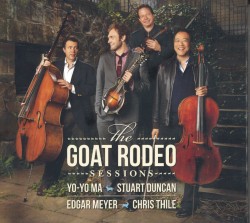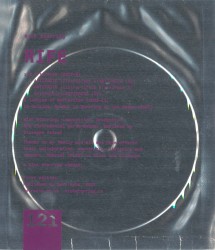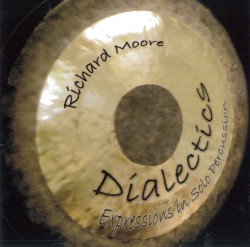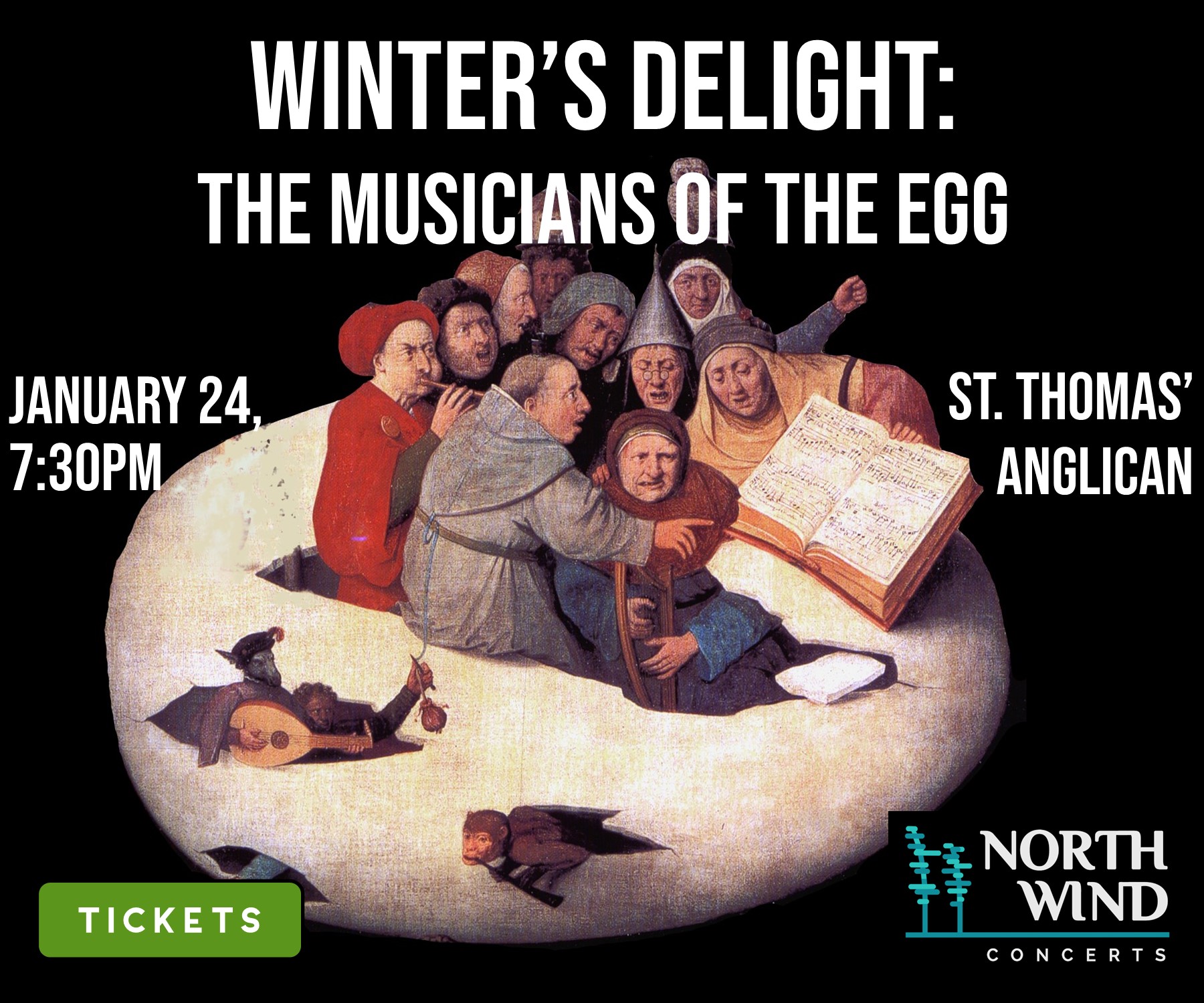 With The Goat Rodeo Sessions (SONY 88697891862) being touted as Yo-Yo Ma’s most successful release to date, it likely doesn’t need my help with promotion. But I can’t help but mention it as it touches on so many of my own musical interests. Evidently a “Goat Rodeo” is something which depends on an improbable number of high risk factors all coming together at once. Hyperbole aside, this recording is the confluence of four very busy musicians from across the musical spectrum and it is a treat from start to finish. Of course we are aware of Ma’s diverse interests in the field of classical music, and his world and roots music projects like Silk Road and earlier collaborations with Mark O’Connor and Edgar Meyer. On this outing bassist Meyer also plays piano and gamba. The other contributors, Nashville session-man Stuart Duncan and bluegrass star Chris Thile, respectively add fiddle, fretless banjo, mandolin and plectrum banjo; and mandolin, guitar, gamba, fiddle and vocals to the mix. Meyer, Duncan and Thile also share writing credits on all the tunes leaving Ma the odd man out simply playing his cello. But with the bottom end so ably anchored by Meyer, Ma gets to exploit the upper reaches of his instrument and the resulting ensemble is an extraordinary string band. Add the lovely voice of Anife O’Donovan on a couple of tracks and you have a wonderfully diverse album which, while firmly rooted in American folk traditions, incorporates a wealth of influences.
With The Goat Rodeo Sessions (SONY 88697891862) being touted as Yo-Yo Ma’s most successful release to date, it likely doesn’t need my help with promotion. But I can’t help but mention it as it touches on so many of my own musical interests. Evidently a “Goat Rodeo” is something which depends on an improbable number of high risk factors all coming together at once. Hyperbole aside, this recording is the confluence of four very busy musicians from across the musical spectrum and it is a treat from start to finish. Of course we are aware of Ma’s diverse interests in the field of classical music, and his world and roots music projects like Silk Road and earlier collaborations with Mark O’Connor and Edgar Meyer. On this outing bassist Meyer also plays piano and gamba. The other contributors, Nashville session-man Stuart Duncan and bluegrass star Chris Thile, respectively add fiddle, fretless banjo, mandolin and plectrum banjo; and mandolin, guitar, gamba, fiddle and vocals to the mix. Meyer, Duncan and Thile also share writing credits on all the tunes leaving Ma the odd man out simply playing his cello. But with the bottom end so ably anchored by Meyer, Ma gets to exploit the upper reaches of his instrument and the resulting ensemble is an extraordinary string band. Add the lovely voice of Anife O’Donovan on a couple of tracks and you have a wonderfully diverse album which, while firmly rooted in American folk traditions, incorporates a wealth of influences.
 Local cellist Nick Storring was also the 2011 recipient of the Canadian Music Centre’s Toronto Emerging Composer Award. Like Ma, Storring works in a variety of genres, but unlike his mainstream counterpart, pretty much all of Storring’s excursions are far from the beaten path. Rife, a recent solo release on the adventurous British label Entr’acte (121 www.entracte.co.uk), features electronic compositions created over the past six years. Artifacts, takes as its main sound source a “near-broken” 7/8 size violin given to the composer by his grandmother. After nearly 22 years as a wall ornament the instrument became the inspiration for this extended suite. Although we are occasionally aware of the sound of the violin being plucked or bowed, for the most part the source is obscured by extensive electronic processing, computer manipulation, recording onto a dictaphone whose power supply was shorting out and the use of intentionally damaged CDRs and deliberately corrupted MP3 files. You wouldn’t know this from the liner notes however, which are literally non-existent. The distinctive packaging — a silver foil heat-sealed sleeve with purple lettering listing the tracks, brief credits and the websites of the publisher and the composer — is certainly eye-catching and presumably cost-effective, but ultimately does a disservice to the product. I think Storring is of the same opinion because when he sent the disc he followed up with a note saying that given the “peculiar style of the packaging” he felt he should provide an info-sheet with background about himself and the pieces. Although the information is available on the Entr’acte website, this fact is not mentioned on the packaging. The other works are Indices of Refraction (2005-2011) which uses various instruments, field recordings and mixer feedback, and Outside, Summer is Bursting at the Seams which cites only cello but the sounds here are every bit as varied as those in the other compositions. This is an intriguing release by a young composer/performer well worthy of our attention.
Local cellist Nick Storring was also the 2011 recipient of the Canadian Music Centre’s Toronto Emerging Composer Award. Like Ma, Storring works in a variety of genres, but unlike his mainstream counterpart, pretty much all of Storring’s excursions are far from the beaten path. Rife, a recent solo release on the adventurous British label Entr’acte (121 www.entracte.co.uk), features electronic compositions created over the past six years. Artifacts, takes as its main sound source a “near-broken” 7/8 size violin given to the composer by his grandmother. After nearly 22 years as a wall ornament the instrument became the inspiration for this extended suite. Although we are occasionally aware of the sound of the violin being plucked or bowed, for the most part the source is obscured by extensive electronic processing, computer manipulation, recording onto a dictaphone whose power supply was shorting out and the use of intentionally damaged CDRs and deliberately corrupted MP3 files. You wouldn’t know this from the liner notes however, which are literally non-existent. The distinctive packaging — a silver foil heat-sealed sleeve with purple lettering listing the tracks, brief credits and the websites of the publisher and the composer — is certainly eye-catching and presumably cost-effective, but ultimately does a disservice to the product. I think Storring is of the same opinion because when he sent the disc he followed up with a note saying that given the “peculiar style of the packaging” he felt he should provide an info-sheet with background about himself and the pieces. Although the information is available on the Entr’acte website, this fact is not mentioned on the packaging. The other works are Indices of Refraction (2005-2011) which uses various instruments, field recordings and mixer feedback, and Outside, Summer is Bursting at the Seams which cites only cello but the sounds here are every bit as varied as those in the other compositions. This is an intriguing release by a young composer/performer well worthy of our attention.
 Dialectics – Expressions in Solo Percussion is a new CD by Richard Moore (www.richardmoore.ca). It juxtaposes works for relatively pitch-less instruments — kettle drums, bass drums, drum set and maracas — with pieces for melodic instruments including vibraphone, marimba and two members of the hammered-dulcimer family: the large Eastern European cimbalom and its tenor counterpart, the Austrian hackbrett. The opener, March for Two Pairs of Kettledrums was written more than three centuries ago by Jacques Philidor. Originally intended for two players placed antiphonally, Moore uses overdubbing to play the duet with himself in a convincing manner. The title track is a 1999 composition for two large bass drums by Moore himself. The driving first movement Thesis is reminiscent of the surf-rock classic Wipeout. Antithesis is introspective, combining hand drumming with the eerie sounds produced by drawing rubber mallets across the skin of the drum heads. Without a noticeable break Synthesis grows out of the quiet and builds back to the opening movement’s frantic pitch. Moore’s transcription of Max Roach’s The Drum Also Waltzes is an extended drum solo using a traditional jazz kit which features a bass drum and high-hat theme alternating with improvised sections. Moore is one of very few cimbalom players in our midst and interspersed with these percussive offerings we are treated to his own adaptation of an Andante for solo piano by Bela Bartok on this distinctive instrument, plus an original work by the Bavarian composer Frederik Schwenk who takes melodies from the folk repertoire of the Finnish kantele, yet another ethnic dulcimer, and adapts them for the hackbrett in a suite that features hammered strings in the outer movements and plucked strings in the middle. This is followed by an unusual piece by Mexican composer Javier Alvarez in which the performer is instructed to improvise using maracas over an electronic track which varies from environmental to industrial sounds and gradually transforms into a gentle folk melody. Moore’s improvisation is so well integrated that it is hard to realize it is not a part of the original soundscape. Frankly, I wish the disc ended there. Moore is an accomplished musician and these tracks demonstrate his command of many aspects of the contemporary percussionist’s arsenal. The disc however continues with Bach’s Third Suite for Solo Cello performed on a marimba. Perhaps it is just my prejudice as a cellist, but I feel there is simply not enough resonance, especially in the lowest register of the marimba, to do the music justice. Certainly Bach can withstand being translated into virtually any instrumental form, but the question for me is does the music benefit from the translation and in this instance my answer is no.
Dialectics – Expressions in Solo Percussion is a new CD by Richard Moore (www.richardmoore.ca). It juxtaposes works for relatively pitch-less instruments — kettle drums, bass drums, drum set and maracas — with pieces for melodic instruments including vibraphone, marimba and two members of the hammered-dulcimer family: the large Eastern European cimbalom and its tenor counterpart, the Austrian hackbrett. The opener, March for Two Pairs of Kettledrums was written more than three centuries ago by Jacques Philidor. Originally intended for two players placed antiphonally, Moore uses overdubbing to play the duet with himself in a convincing manner. The title track is a 1999 composition for two large bass drums by Moore himself. The driving first movement Thesis is reminiscent of the surf-rock classic Wipeout. Antithesis is introspective, combining hand drumming with the eerie sounds produced by drawing rubber mallets across the skin of the drum heads. Without a noticeable break Synthesis grows out of the quiet and builds back to the opening movement’s frantic pitch. Moore’s transcription of Max Roach’s The Drum Also Waltzes is an extended drum solo using a traditional jazz kit which features a bass drum and high-hat theme alternating with improvised sections. Moore is one of very few cimbalom players in our midst and interspersed with these percussive offerings we are treated to his own adaptation of an Andante for solo piano by Bela Bartok on this distinctive instrument, plus an original work by the Bavarian composer Frederik Schwenk who takes melodies from the folk repertoire of the Finnish kantele, yet another ethnic dulcimer, and adapts them for the hackbrett in a suite that features hammered strings in the outer movements and plucked strings in the middle. This is followed by an unusual piece by Mexican composer Javier Alvarez in which the performer is instructed to improvise using maracas over an electronic track which varies from environmental to industrial sounds and gradually transforms into a gentle folk melody. Moore’s improvisation is so well integrated that it is hard to realize it is not a part of the original soundscape. Frankly, I wish the disc ended there. Moore is an accomplished musician and these tracks demonstrate his command of many aspects of the contemporary percussionist’s arsenal. The disc however continues with Bach’s Third Suite for Solo Cello performed on a marimba. Perhaps it is just my prejudice as a cellist, but I feel there is simply not enough resonance, especially in the lowest register of the marimba, to do the music justice. Certainly Bach can withstand being translated into virtually any instrumental form, but the question for me is does the music benefit from the translation and in this instance my answer is no.
We welcome your feedback and invite submissions. CDs and comments should be sent to: The WholeNote, 503–720 Bathurst St., Toronto ON M5S 2R4. We also encourage you to visit our website, www.thewholenote.com, where you can find added features including direct links to performers, composers and record labels, “buy buttons” for online shopping and additional, expanded and archival reviews.
—David Olds, DISC discoveries@thewholenote.com



